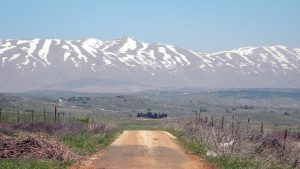The phrase translated “cast them into hell” in 2 Peter 2:4 is the Greek word tartarōo, a verb that literally means “thrust down to Tartarus.” This is the only time in the New Testament that the word is used, so it requires special attention.

Tartarus was separate from Hades, a place of torture and torment even lower than Hades in Greek cosmology. It was believed to be as far below Hades as Earth is below Heaven. And Peter, under the inspiration of the Holy Spirit, chose that word to describe the punishment reserved for the angels who had engaged in illicit sexual relations with human women. Stick a mental bookmark there because we’ll have to come back to this.
The extra-biblical books of Enoch and Jubilees expand on the story, adding detail and context that’s not in the Bible. Mount Hermon is where two hundred Watchers, a class of angelic being mentioned in chapter 4 of the book of Daniel, descended and began cavorting with human women. From these unions came the Nephilim, the giants of Genesis 6.
The Watchers, according to Enoch, were led by Semjâzâ, who was apparently worried that he’d take the fall for what they were about to do:
And Semjâzâ, who was their leader, said unto them: ‘I fear ye will not indeed agree to do this deed, and I alone shall have to pay the penalty of a great sin.’ And they all answered him and said: ‘Let us all swear an oath, and all bind ourselves by mutual imprecations not to abandon this plan but to do this thing.’ Then sware they all together and bound themselves by mutual imprecations upon it. And they were in all two hundred; who descended ⌈in the days⌉ of Jared on the summit of Mount Hermon…[1]
The trade offered by the Watchers was knowledge, just as it was in Eden. In exchange for the pleasures of the flesh, Semjâzâ and his minions offered charms and enchantments, astrology, the art of making weapons, cosmetics, and writing, among other things—presumably arts humans would have developed or discovered over time rather than downloaded on society all at once.
However, the giant offspring of these unholy unions, the Nephilim, pillaged the Earth and endangered humanity. They consumed everything men had. When that wasn’t enough, they began eating people and even each other. Enoch describes the giants as creatures of insatiable desire who threatened to terminate the bloodline of the future Messiah by violence—and, apparently, by corrupting the human genome.
The Book of Jasher suggests that the transgression of the Watchers and the Nephilim went beyond corrupting humankind, including “the mixture of animals of one species with the other” (Jasher 4:18).
We can only speculate as to what that was about. Was this where the legends of chimeric beings like centaurs and satyrs began? Or were they legends at all? But we do know that Yahweh sent a flood that rid the earth of all flesh except for the eight people and the animals aboard the ark. The Watchers who started it all, according to Peter and Jude, are chained in Tartarus, and they’ll stay there until “the judgment of the great day.”
But Mount Hermon’s role in history didn’t end with the flood of Noah. Another group of fallen bene elohim set up shop on the mountain after the showdown at Babel.
According to Belgian scholar Edward Lipinski, Hermon was known to the ancient world not only as the secret dwelling place of the Anunnaki, it was the mountain of the divine assembly of the northwest Semitic god El, the creator god of their pantheon.[2] Mount Hermon is where El held court with his consort Asherah and the “seventy sons of El.”
Remember that number, seventy. We will see it again.
El was a name that came to be used in Hebrew as a generic term for “god”—El, Elohim, El Elyon, etc. It’s possible that the epithet El Shaddai, possibly meaning “god of the mountain,” was applied first to El. Another Mesopotamian god, Amurru, was called “Bel Šade,” or “lord of the mountain.” (The š sounds like “sh.”) This was another PSYOP by the Fallen—appropriating a name by which Yahweh identified Himself to confuse things. In Exodus, Yahweh told Moses that it was by the name El Shaddai, usually rendered “God Almighty” in our English Bibles, that He introduced Himself to Abraham, Isaac, and Jacob (Exodus 6:3). That’s why Jacob became Isra-el, not Isra-yahu.
Of course, skeptics take this to mean that Jews and Christians are confused about who we worship. It’s El, they claim, and the followers of Yahweh are so dense we’ve gotten it wrong for the last 3,500 years. In point of fact, however, it’s the skeptics who have fallen for another PSYOP by the Enemy, who don’t care what we believe as long as it’s not the one thing that’s true.
But make no mistake: El of the Canaanites was not Yahweh of Israel, and Yahweh was not El. In the Canaanite pantheon, El was a figurehead. Real power was wielded by Ba`al, the king of the gods. In the Canaanite myths, there was a power struggle between the gods over who would hold that title, and El didn’t seem to have the power or the will to just pick a winner. Neither did he seem all that interested in ruling himself. If you had to pick a word to describe El, it would be “semi-retired.”
That is definitely not the God of the Bible.
One of the fascinating aspects of the story of Gilgamesh is that archaeologists generally consider him a real, historic character. In 2003, a team using magnetometry to map the site of ancient Uruk found “a man-made construction in the midst of what was once the riverbed of the Euphrates” consistent with the description of the tomb of Gilgamesh in the epic poem about the Sumerian hero.[3] However, their discovery came a month after the United States military invaded Iraq in 2003, which put a stop to the dig.
Scholars have known for years that there are parallels in Mesopotamian legend and the biblical accounts of the patriarchs. Enoch is similar to an antediluvian king named Enmeduranki, and Noah is variously called Utnapishtim (Babylon), Ziusudra (Sumer), and Atra-Hasis (Akkad). But even those accounts are part of a supernatural PSYOP. For example: The accounts from Mesopotamia portray Gilgamesh as a mighty warrior, a hero, two-thirds god and one-third man. He has adventures and slays monsters, notably Humbaba, or Huwawa, the defender of the faraway cedar forest who’d been assigned to terrorize humans by the god Enlil.
Some scholars believe Humbaba might also have been pronounced “huwawa.” Dr. David Livingston, founder of Associates for Biblical Research, points out that Huwawa sounds a lot like Yahweh. If he’s right, then it’s possible we’ve discovered another PSYOP: The real mission of Gilgamesh, as the Fallen wanted Mesopotamians to understand it, was to kill the monstrous guardian of the secret home of the gods—Yahweh.[4]
In a previous article, we showed how the anointed guardian cherub of Eden, the nachash who lured Adam and Eve into sin, was cast down from God’s holy mountain to become lord of the dead. We will show in a future article in this series why Jesus chose Mount Hermon for several very specific incidents—strategic events aimed at the rebellious bene elohim. So to avoid repeating ourselves, we’ll hold some information back until later in this series. But we’ll share this: The people who lived in the Levant in the ancient world knew that Bashan, the kingdom of Og at the base of Mount Hermon, was known as the literal entrance of the netherworld.
Consider this: Is it possible that the foul reputation of Mount Hermon and the region of Bashan grew out of an historic event—the literal fall from Eden, God’s holy mountain, by the rebel who was cast down by God?
Many scholars have noted the similarities between Eden and the garden of the gods sought by Gilgamesh, the secret dwelling place of the Anunnaki. If Hermon was Eden, it could explain why the rebellious gods who want to establish their own mount of assembly have been drawn to it, to defile it, since the beginning of time.
Or maybe the Fallen wanted to make Hermon into a new Eden—a “mount of assembly” that would replace the throne of God.
[1] Book of 1 Enoch 6:3–6a (R.H. Charles translation).
[2] Edward Lipinski, “El’s Abode: Mythological Traditions Related to Mount Hermon and to the Mountains of Armenia.” Orientalia Lovaniensa Periodica 2 (1971), p. 19.
[3] Charles Recknagel, “Iraq: Archaeological Expedition Mapping Ancient City Of Uruk.” Radio Free Europe/Radio Free Liberty, May 3, 2002. https://www.rferl.org/a/1099592.html, retrieved 12/29/22.
[4] Dr. David Livingston, “Who Was Nimrod?” DaveLivingston.com (http://davelivingston.com/nimrod.htm), retrieved 3/8/19.



In my last comment, I suggested that Eden is Earth and that “The Garden” was the portal between the seen and unseen realms.
I was so excited to suggest that the Garden portal was located at Hermon which is why Jesus made His statement to reclaim it (Mat 16:18). Based on your last paragraph it seems believe that may be a possibility, as well. You ruined my buzz of sharing some new thoughts but it is exciting to see someone else – especially someone as scholarly as yourself – come to similar conclusions. Thanks for all of the work you and the Mrs do.
Fascinating information, thank you so much. I’d like to ask a question: the Sumerian god Marduk sent the Apkallu to the abyss, because they supposedly helped humans when Marduk wanted to get rid of them. His argument was that humans (created as slaves) were too noisy. What does it mean? What is the symbolism of killing Tiamat? Some sociologist explain this myths as reflections of the social structure changing from tribal communities to monarchy (henotheism).
I would appreciate enormously your opinion.
Let the Lord bless you and your wife,
greeting from Marisa Monti, Slovenia.